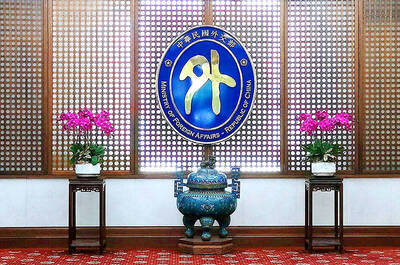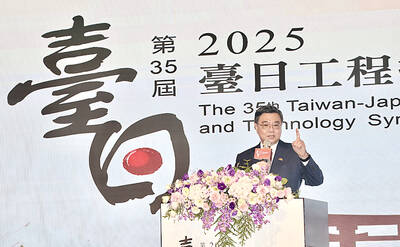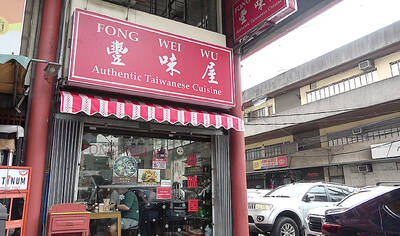The then-Chinese Nationalist Party (KMT) government during the Martial Law era ran extensive intelligence networks to spy on students, with thousands of agents and informants stationed on college and university campuses, the Transitional Justice Commission has said.
The party leadership in the 1970s designated deterring and stopping student activism a top priority, the commission said.
The KMT coordinated national intelligence and internal security agencies, its party system and administrative sections of the Ministry of Education to establish the spy network to monitor and report political discourse and activities by university students, it said.

Photo courtesy of the Transitional Justice Commission
The spying program was given the codename “Operation Spring Breeze,” which mandated all college and university administrations to form a top-level “school security group” for espionage as well as the mobilization of agents and informants, with the stated aim to “set up networks at every level and have an informant in every classroom,” documents showed.
“The KMT leadership took lessons from its defeat in the Chinese Civil War at the hands of Chinese Communist troops, the ‘Diaoyutai Movement’ protesting Japanese claims to the Senkaku Islands [Diaoyutai Islands, 釣魚台] in the 1970s and a student movement calling for democracy in South Korea at the time. So they wanted to exterminate any student activism in Taiwan,” said a commission member who spoke on condition of anonymity.
There were more than 80 colleges and universities in Taiwan at the time, the commission member said, adding that documents showed that the KMT planted covert agents, moles and informants in classrooms, lecturers’ offices, students’ social and recreational clubs and dormitories, even infiltrating school staff groups.
“The espionage network had the main goals of surveillance, as well as detecting and stopping Chinese Communist spies, Taiwanese independence advocates and conspiracy activities. Its mission was to root out all political subterfuge and prevent any initiation of student activism,” the commission member said.
The operation involved about 3,900 people as paid informants and covert agents in 1975, the commission said.
Citing National Chung Hsing University as an example, the commission member said that 59 people — 31 school employees and 28 students — were paid by and received instructions from the network to monitor and spy on students that year.
The informants filed 23 reports on staff activities, 24 reports on student club activities, and seven reports on “suspicious talks” by lecturers and students, they said.
The number of covert agents, moles and informants rose to 5,041 in 1983, the commission members have found.
“This is such a big, horrifying number,” commission Acting Chairwoman Yang Tsui (楊翠) said.
Documents showed that political dissent increased every year, with university students forming clubs with nonconformist views, so the KMT leadership increased the frequency of meetings to discuss the operation from once a year to twice a month to receive reports from campus security groups.
The meetings, which were held at the ministry, were attended by KMT members, and officials from national intelligence and internal security agencies, documents showed.
National intelligence and internal security officials initiated countermeasures and plans to deal with what they deemed “abnormal activities” on campuses, specifically to crack down on people perceived to hold dissenting views, they showed.
Minutes from a 1983 meeting quoted a KMT Department of Youth Affairs representative as saying: “We should persuade and turn the opinions around for less serious cases, while those who are stubborn and would not change their minds, we should send them to the state intelligence agency to be dealt with severely.”
The minutes also quoted a convener as saying: “For those who could pollute the minds of the students, and endanger national security, we have to assess whether to continue to employ these lecturers, and the education ministry of course has the responsibility to collect this information. We thank the Department of Youth Affairs for providing the information.”
The then-KMT regime believed that National Taiwan University (NTU) was a hotbed of political opposition and therefore directed significant resources to monitor its faculty and students, a commission member said, citing documents showing that the then-education minister put in writing that the ministry “requested the Department of Youth Affairs to guide and direct our strategic deployments regarding the NTU Graduate Student Association’s re-election, and editorial activities by student clubs’ publications.”
A hallmark of the regime’s counterintelligence operations at the time was to minimize discernible evidence of the KMT’s involvement, if not its substance, the commission said, adding that for instance, a party youth affair official had told the NTU that “in so far as possible, the [university’s] student affairs office should be seen executing the decisions, which we could make with school officials in a task force established outside of the school.”
Retired academic Lee Yeng-chyh (李永熾) has authored a memoir that stirred memories of institutional surveillance and political suppression on campuses during the White Terror era.
Lee, a historian of Japan who taught at NTU, on May 1 published the book A Free Man on the Margins: The Choices of A Historian (邊緣的自由人:一個歷史學者的抉擇), which in part touches on the school’s experience of the Kaohsiung Incident in 1979.
The incident refers to a crackdown launched by the military police on a march set to commemorate Human Rights Day, which resulted in violence that the authorities later used as a pretext to arrest virtually every known opposition leader in the nation.
Lee wrote that in the days following the incident, a rumor began to spread that a student at the history department named Chou Wan-yao (周婉窈) was conspiring to stage a protest outside the Presidential Office Building.
“Department chair Sun Tung-hsun (孫同勛) believed action should be taken to crack down [on Chou], as he was disturbed by the prospect of trouble,” he wrote, adding that Sun came to him to discuss the matter because he was Chou’s adviser at the time.
“I told Sun that the crackdown was absolutely the wrong thing to do. No action should be taken on the basis of rumors on a thing that has not even happened. Moreover, as a matter of principle, the department should try to understand what the student wants to achieve and why,” he wrote.
Chou, who later became a Taiwanese history professor at the university, wrote on Facebook that she never intended to stage such a protest.
Chou said the authorities suspected her of being a dissident due to her political views and academic interests, and that a female military instructor assigned to the history department made multiple attempts to frame her for nonexistent crimes.
Citing professor Cheng Ching-jen (鄭欽仁), Chou said the instructor once demanded that the department hand over documents bearing her handwriting, supposedly because she was linked to a bombing plot targeting Taipei’s Gongguan (公館) area.
The same instructor also ordered a classmate to spy on Hu Hui-ling (胡慧玲) — who later became a Taiwanese historian and author — but “fortunately the informant turned out to be a friend of Hu, and did not divulge any information that could harm Hu,” Chou said.
Chou added that to her knowledge, she was also under surveillance and she has a good idea who the informant was, but “unfortunately, that person was not my friend.”

The Ministry of Foreign Affairs (MOFA) yesterday voiced dissatisfaction with the Comprehensive and Progressive Agreement for Trans- Pacific Partnership (CPTPP), whose latest meeting, concluded earlier the same day, appeared not to address the country’s application. In a statement, MOFA said the CPTPP commission had "once again failed to fairly process Taiwan’s application," attributing the inaction to the bloc’s "succumbing to political pressure," without elaborating. Taiwan submitted its CPTPP application under the name "Separate Customs Territory of Taiwan, Penghu, Kinmen and Matsu" on Sept. 22, 2021 -- less than a week after China

ALIGNED THINKING: Taiwan and Japan have a mutual interest in trade, culture and engineering, and can work together for stability, Cho Jung-tai said Taiwan and Japan are two like-minded countries willing to work together to form a “safety barrier” in the Indo-Pacific region, Premier Cho Jung-tai (卓榮泰) yesterday said at the opening ceremony of the 35th Taiwan-Japan Modern Engineering and Technology Symposium in Taipei. Taiwan and Japan are close geographically and closer emotionally, he added. Citing the overflowing of a barrier lake in the Mataian River (馬太鞍溪) in September, Cho said the submersible water level sensors given by Japan during the disaster helped Taiwan monitor the lake’s water levels more accurately. Japan also provided a lot of vaccines early in the outbreak of the COVID-19 pandemic,

Kaohsiung Mayor Chen Chi-mai (陳其邁) on Monday announced light shows and themed traffic lights to welcome fans of South Korean pop group Twice to the port city. The group is to play Kaohsiung on Saturday as part of its “This Is For” world tour. It would be the group’s first performance in Taiwan since its debut 10 years ago. The all-female group consists of five South Koreans, three Japanese and Tainan’s Chou Tzu-yu (周子瑜), the first Taiwan-born and raised member of a South Korean girl group. To promote the group’s arrival, the city has been holding a series of events, including a pop-up

A home-style restaurant opened by a Taiwanese woman in Quezon City in Metro Manila has been featured in the first-ever Michelin Guide honoring exceptional restaurants in the Philippines. The restaurant, Fong Wei Wu (豐味屋), was one of 74 eateries to receive a “Michelin Selected” honor in the guide, while one restaurant received two Michelin stars, eight received one star and 25 were awarded a “Bib Gourmand.” The guide, which was limited to restaurants in Metro Manila and Cebu, was published on Oct. 30. In an interview, Feng Wei Wu’s owner and chef, Linda, said that as a restaurateur in her 60s, receiving an